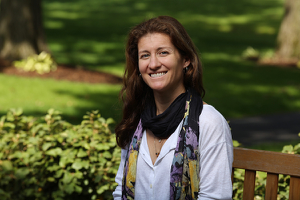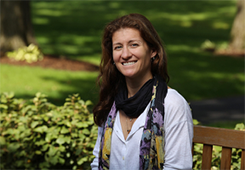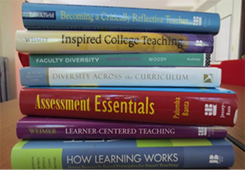Surprises, Challenges, and Successes In My First Year at Tufts

We asked new Tufts faculty members to comment on what their first year had been like, and to offer some advice to new colleagues. Here’s what Dr. Jill Weinberg had to say.
Jill D. Weinberg is an Assistant Professor of Sociology and an affiliated scholar at the American Bar Foundation in Chicago, IL. She joined Tufts University after serving as a Visiting Assistant Professor at DePaul University.
What surprised you as a new faculty member at Tufts?
I heard Tufts students were smart. And in fact they are – they play with ideas, challenge ideas and the readings. At my previous institution (DePaul) many of the students had a lot of life going on. They were commuter students who worked part- time and commuted. A fair amount of the student population were returning to school, so I would approach teaching with the assumption that they didn’t do the reading. Whereas here, the baseline is that all the students have done the reading. So in my classes, I have students apply concepts they’ve read to real-life examples beyond the reading. It’s easy to just do a lecture and get into the quotes and the granular points in the text, but it’s really enjoyable to draw upon newspaper articles and pop culture: that makes the teaching very malleable and very relevant. Students really like it. Not to mention, I look really cool when I have students analyze an episode of the Netflix series “Black Mirror” to get them thinking about social interaction. So that’s been really enjoyable.
What were some of the challenges you faced during your first year teaching at Tufts?
There’s a thing I never thought of until I came to Tufts – thinking about an inclusive classroom. How I thought about inclusion from my previous teaching was to get the students literally included, so that meant different activities, assignments, and playing upon strengths of different students. I had a very narrow sense of what inclusion looked like. [Inclusion is not only bringing students into the classroom with the various activities but also creating a safer space]. I study deviance. I study death and crime, prison and all of these things that could actually relate to these students on a very intimate level. I think it’s important to engage with these concepts [in class] but also to make sure that [students] feel like their voices matters on this higher level of acknowledgement, not simply, “Oh you made a really great point with this reading.” Really understanding personal background is very hard to do. I don’t have office hours where I sit down with every student and say “Tell me all about yourself.” But every so often students signal to me parts of their biography in how they have approached a reading or how they have thought about a reading.
And especially for quantitative methods – what does inclusion look like when I’m teaching a very numbers-based course? People would presume it’s highly objective or highly decontextualized in some ways. But I use an example in my quantitative methods class to show how context really matters, even in math- or numbers-based courses. There’s a great website that looks at actual old census survey instruments, and you can track how the U.S. Census documents race, for example, for every ten years since the 1840’s. You can see the growing nuance – even in the labeling. They would offer options of “white” and “negros” in the eaeralier Census surveys. It’s a very crude measure. If you look at the Census in 2010, you see a very elaborate “check all that apply” section, acknowledging all different backgrounds and ethnicities. What we start to see [is] by including different groups on these census surveys, we see that society acknowledging that these different groups are worthy of measurement. We recognize group on a federal, bureaucratic level, whereas if you think about it back in the revolutionary era, there was very little regard for minority populations. In fact they weren’t even viewed as full citizens so there was very little reason or need to even measure how many of them were in existence.
So I’ve been trying to those types of examples to show that how we measure, how we create our statistical modeling, or how we write our surveys can really change the social reality of who counts, who doesn’t count, who’s recognized, and who’s not. This is part of inclusive teaching. I think I could do it better, I think I could do more of it but I never thought about it until I got here.
What were you most proud of about your teaching in your first year?
A considerable challenge that a lot of faculty members face in an R1 school like Tufts is balancing our research and teaching. The culture from when I was in graduate school and the experience of a lot of my peers at other institutions regarding teaching is simply, “just show up and get it done. As long as you’re not below average or have any lawsuits pending, you’re going to be fine for tenure.”
I felt proud that I was able to take teaching seriously and still maintain a fairly decent balance of teaching and research. Part of my success has been bringing my own research into the classroom. Students really like to hear what professors are doing. Maybe I haven’t been in enough classrooms, but I don’t think a lot of professors do that. I show the students my surveys; I show them my data. I think it’s important to cultivate an environment where the students do matter and there is still a way to achieve doing your research. I’ve found it helpful to talk about my research in a way that balances my teaching and research obligations.
What advice would you offer to new faculty now that you have a little time under your belt?
[You can assume that] students are always doing the reading, so part of thinking about your classroom time is to go beyond the concepts and to apply them to new materials or new cases. This makes your class prep time more enjoyable. I don’t want to say it lessens or minimizes it, but there is something to be said for just applying knowledge. Starting the class by asking a simple question, then working through ideas in the readings to answer that question. Students seem to resonate with that more. For me it makes my class work time more enjoyable and less onerous. Students have a natural desire to ask “so what?” You can use the class time to answer that “so what.”
In a course like stats, the agenda is already set. But for more theoretical courses, less is more when it comes to reading. Students are overcommitted, so If you assign 200 pages for one class, students may not get all of it done, but you can engage students pretty effectively by doing maybe three readings and going really in depth. They like it and it makes it easier for you to prep as a faculty member.
I heard this in college, I heard this in grad school, and I say it as a faculty member, everyone says there is so much more to cover, and what you’re getting is only the surface. If we all know this is true, why are we pushing the agenda, of [assigning] 200 pages for every class? It’s not effective and not enjoyable for students, or for class prep. If the goal is to understand these bigger concepts and then apply them in everyday settings, you probably should focus on just getting the concepts and then turning to application, which doesn’t require 200 pages.
In any discipline on this campus there’s always a research component because all of us are researchers. Whether it’s humanities or social sciences or engineering, one thing that makes classroom instruction easier is not only bringing research into the classroom (like your own data), but also getting students engaged in the research process by having them do a mini-research project. You can bring in the library to help find a publicly available data or an archive. Showing [students] how to do research and having them do it in a classroom-setting is a very creative assignment. Students like it; it’s quite frankly what we do; and it’s a pretty easy thing to prepare for when we’re prepping for classes. For example I’ve done mini-ethnographies where students go to court, watch a trial, and take notes. I’m not teaching a field methods course, but I give them the basic tenants of ethnography as a systematic observation of patterns. So what better way than to go to court, watch what people are doing, and how they’re interacting?! They also like mini-interview projects, and they all say “we really like this assignment because it’s different from everything else we’ve gotten in our other classes.



